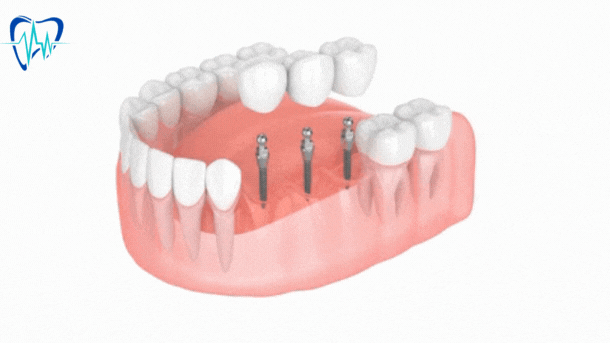What is a dental bridge?
Dental bridges replace missing teeth. Specifically, they can replace one tooth or a row of missing teeth.
As the name implies, this appliance literally “bridges the gap” in your smile. Dentists can create custom bridges that match the shade of your natural teeth.
A dental bridge can be made of different materials, including gold, alloys, or porcelain. When replacing a front tooth, porcelain is most often used because it can be matched to your natural tooth color.
There are different parts that make up a dental bridge:
The components that hold up your dental bridge are called abutments. The word can also refer to the tiny connection posts used in bridges supported by dental implants, even though it is most commonly used to describe natural teeth.
Artificial, or false, teeth called pontics are used to close the space created by missing teeth.
One or more abutments and one or more pontics may be a part of your bridge, depending on your circumstances and the style of bridge you obtain.
Dental bridge types
There are four main types of dental bridges:
- traditional
- cantilever
- Maryland
- implant-supported
The four types of dental bridges are:2
- Traditional fixed bridges are the most common type of bridge. It includes a crown on either side of the pontic(s).
- Maryland dental bridges or resin-bonded bridges are often used to replace front teeth. Instead of crowns, this type of dental bridge uses porcelain or metal frameworks with "wings" that are bonded to the back of your teeth on either side of the gap.
- Implant-supported bridges use an implant for each missing tooth that is surgically embedded into your jawbone during a surgical procedure. The bridge has the pontics in it and will be put over them in a second procedure.
- Cantilever bridges are no longer commonly used. When only one side of the gap has a natural tooth, the pontic(s) are anchored by a single crown on that natural tooth
To determine what type of bridge you need, a dentist will consider several factors, including:
- Your age. (Dentists typically don’t place bridges in children.)
- How many teeth you’re missing.
- The size of the gap.
- The condition of your teeth next to the gap.
- Whether you have natural teeth on both sides of the gap.
- The overall health of your teeth and gums.
- Your personal preferences.
Benefits of Dental Bridges
Dental bridges can provide many benefits, including:
- Giving your mouth and smile a natural look
- Restoring your ability to speak normally, as missing teeth can make it hard to pronounce words (enunciate)
- Maintaining normal facial structure by preventing bone loss from the jaw at the site of the missing tooth/teeth67
- Helping you chew food better
- Preventing adjacent teeth from moving into the empty space, which can cause problems with your bite and other complications8
Disadvantages of dental bridges
Dental bridges also have some drawbacks:
- If decay or trauma results in damage to your abutment teeth, it can weaken your dental bridge.
- If your abutment teeth aren’t strong enough to support your bridge, they can fracture.
- If you don’t properly clean the bridge and underlying gum tissue, plaque and bacteria can cause gum inflammation or cavities.
A dental bridge is a restorative dental treatment used to replace one or more missing teeth. The procedure typically involves the following steps:
- Initial Examination:
- Your dentist will conduct a thorough examination of your oral health, including X-rays, to assess the condition of the missing tooth area and surrounding teeth.
- Preparation of Abutment Teeth:
- The teeth adjacent to the missing tooth (abutment teeth) need to be prepared to support the dental bridge. This involves removing a portion of the enamel to create space for the bridge.
- Impressions:
- After preparing the abutment teeth, your dentist will take impressions of your teeth. These impressions are used to create a model of your teeth, which is then sent to a dental laboratory for the fabrication of the bridge.
- Temporary Bridge (Optional):
- In some cases, your dentist may place a temporary bridge to protect the exposed teeth and gums while the permanent bridge is being made.
- Bridge Fabrication:
- The dental laboratory uses the impressions to create a custom-made bridge that fits your teeth and bite.
- Fitting the Permanent Bridge:
- Once the permanent bridge is ready, you will return to the dentist for its placement. The dentist will check the fit and make any necessary adjustments. It's crucial for the bridge to have a proper fit to ensure comfort and functionality.
- Permanent Bridge Placement:
- The dental bridge is cemented onto the prepared abutment teeth. The dentist will carefully place and secure the bridge in its position, ensuring that it feels natural and functions properly.
- Final Adjustments:
- Your dentist will make final adjustments to the bite and check the overall comfort of the bridge.
- Post-Procedure Care:
- After the procedure, your dentist will provide instructions on oral hygiene practices and care for your new bridge. Regular dental check-ups are important to ensure the bridge's longevity and overall oral health.
Dental bridges are a common and effective solution for replacing missing teeth, restoring both function and aesthetics to the smile.
FAQ
Is it painful to prepare a dental bridge? Because a local anaesthetic is applied while your teeth are being prepared and your dentist is taking an imprint, the bridge treatment is painless. After treatment, taking an analgesic is frequently not essential to relieve discomfort
Can you sleep with a dental bridge in your mouth? Traditional or implant-supported bridges are permanently in your mouth, and you can wear them while you sleep. However, you should remove removable bridges at night, sometimes called partial dentures.



 Dental Checkup Services
Dental Checkup Services
 Our range of products
Our range of products
 Oral Care Blogs
Oral Care Blogs
